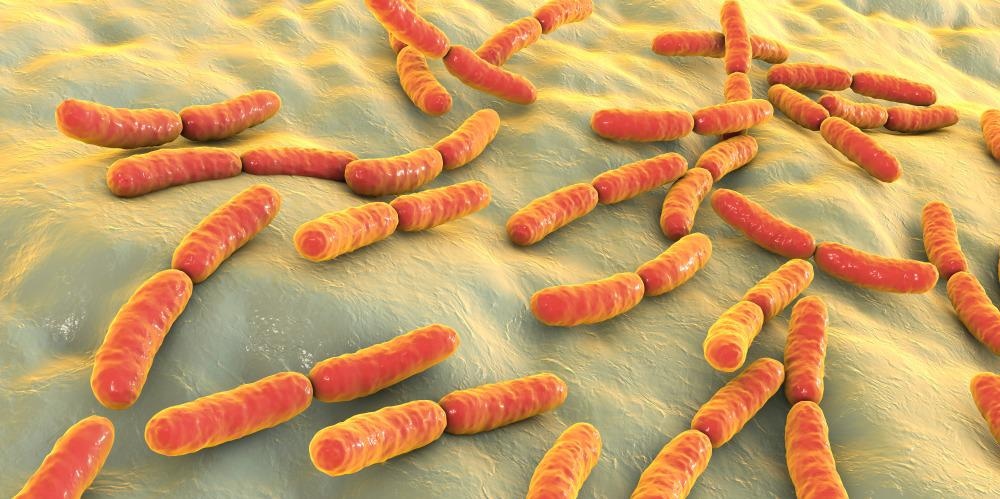A group of researchers recently published a paper in the journal ACS Applied Nano Materials that demonstrated the antibiofouling and antibacterial properties of nanopatterned polymers at sub-100-nanometer scale.

Study: Nanopillar Polymer Films as Antibacterial Packaging Materials. Image Credit: Kateryna Kon/shutterstock.com
Technologies that can prevent or control bacterial growth on surfaces play a crucial role in reducing microbial contamination. Microbial contamination of surfaces severely impacts materials such as composites and plastics that are used in the textile industry, and for wearable electronics and food packaging.
Specifically, microbial contamination in food packaging can prematurely deteriorate food quality and lead to food wastage. Thus, antibacterial nanocomposite materials were developed for packaging, which has directly benefitted the food packaging sector by reducing microbial growth on packaging and extending the shelf life of several food products.
Typically, metal nanoparticles (NPs) were added to the packaging materials such as polymers and plastics to prevent microbial growth. However, concerns related to their cytotoxicity necessitated the development of newer alternatives.
Nanostructured polymeric surfaces can act as an innovative solution to the issues posed by the other antimicrobial packaging alternatives. These polymeric surfaces display an impressive antifouling and antibacterial activity and can be patterned at various length scales with high reproducibility to improve their antibacterial properties.
A combination of plasma etching, colloidal lithography, and nanoimprint lithography is the most prominent patterning strategy developed to create a range of micro-nanopatterned polymer topographies.
However, the antibacterial efficiency of nanopatterns comprising high aspect ratio (AR) structures such as nanopillars heavily relies on the nanopattern array geometry. Until now, efforts to devise an optimal surface nanopattern suitable for effective antibacterial action were unsuccessful owing to several technical challenges.
In this study, both the ultraviolet (UV) and thermal nanoporous anodic aluminum oxide (AAO) template-assisted nanoimprint lithography were performed to precisely fabricate sub-100 nm-scale nanopatterns on nylon, acrylic, polypropylene (PP), and polyethylene terephthalate (PET).
The antibacterial efficiency of nanostructured polymer films toward Gram-negative Pseudomonas aeruginosa and Gram-positive Staphylococcus aureus was investigated using these synthesized polymer substrates.
Moreover, researchers fabricated nylon and acrylic nanopatterned substrates with nanopillars of different periodicity and height in order to evaluate the effect of these individual structural parameters on the antimicrobial activity of these materials.
The Study
Resin materials used in this study include a nylon-100 μm film, a PET 250 μm film, a PP 130 μm film, and an acrylic film. Nanopatterned superhydrophobic and superhydrophilic acrylic films were prepared using the fluoroalkyl group-modified PAK-02 acrylic resin and poly (ethylene oxide)-modified PAK-02 acrylic resin, respectively.
Nanopillars of different dimensions and geometry were created by both nanoimprint lithography and thermal nanoimprinting using the AAO-fabricated porous alumina fold. A desktop press device was used to produce 5 × 7 cm2 nylon, PP, and PET nanopatterned films through thermal nanoimprint of the polymer films.
A porous AAO mold with pores of 30 nm diameter and 60 nm pitch was utilized to create comparable patterns in nylon, PP, and PET films, while a mold with pores of 60 nm diameter and 60 nm pitch was used to create patterns on acrylic films.
The anodization time was adjusted to prepare anodic porous alumina molds with varying hole depths to achieve nanopillars of different heights. The UV nanoimprint lithography was performed to fabricate acrylic nanopillar films. Nonstructured films were used as a control in the study.
A FEI Nova Nano scanning electron microscope (SEM) was used to observe the nanopillar patterns, while Dropmaster 300 and DSA10MK2 were employed to analyze surface wetting properties. Bacterial stocks of Staphylococcus aureus and Pseudomonas aeruginosa were refreshed on nutrient agar from −80 °C to 37 °C for 24 h.
Observations
The hydrophobicity of all films increased due to nanopatterning, excluding the hydrophilic acrylic films where the water contact angle reduced from ∼44° to ∼10°. The bacterial attachment comparisons between nanostructured and nonstructured films indicated substantial reductions in Staphylococcus aureus cell attachment to nylon, acrylic, and PET nanopillar films.
Nanopillar PP films demonstrated an increased attachment to both bacterial strains compared to unstructured control substrates. Both hydrophilic and hydrophobic nanostructured acrylic surfaces experienced a slight increase in Pseudomonas aeruginosa attachment compared to the nonstructured control surfaces, while PET films experienced a decrease in attachment.
Nylon films experienced a small decrease in Pseudomonas aeruginosa attachment.
Against Staphylococcus aureus, the antimicrobial activity of PP and PET nanostructured films was modest, while nylon and acrylic nanostructured films attained a higher rate of bacterial cell death.
However, against Pseudomonas aeruginosa, the PET nanostructured films were ineffective, while nylon, hydrophilic and hydrophobic acrylic, and PP nanostructured films attained significant reductions in the number of attached Pseudomonas aeruginosa cells.
Observations from the bacterial cell morphology indicated cellular damage in the bacteria attached to the nanostructured polymers.
Acrylic nanostructured surface patterns with AR=1 and pitch=60 nm showed the highest degree of antifouling and antibacterial efficiency against Staphylococcus aureus, and patterns with AR=4 and pitch=60 nm against Pseudomonas aeruginosa.
At the optimal nanopillar pitch of 60 nm, the antimicrobial and antifouling efficiency of nylon nanopatterned surfaces against Pseudomonas aeruginosa and Staphylococcus aureus were highest at nanopillar heights above 100 nm.
Taken together, the findings of this study demonstrated that sub-100-nanometer scale nanopatterned polymers are effective as antibacterial materials, with nylon and acrylic nanostructured films having a superior antimicrobial activity compared to other polymers.
Reference
Masuda, H., Kusaka, H., Saita, S. et al.(2022) Nanopillar Polymer Films as Antibacterial Packaging Materials. ACS Applied Nano Materials. https://doi.org/10.1021/acsanm.1c0425
Disclaimer: The views expressed here are those of the author expressed in their private capacity and do not necessarily represent the views of AZoM.com Limited T/A AZoNetwork the owner and operator of this website. This disclaimer forms part of the Terms and conditions of use of this website.